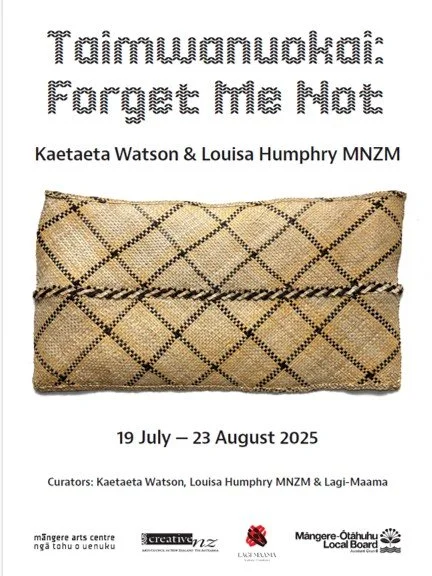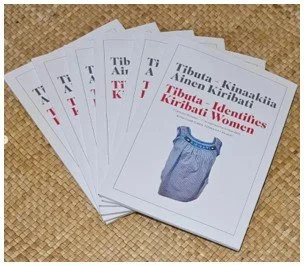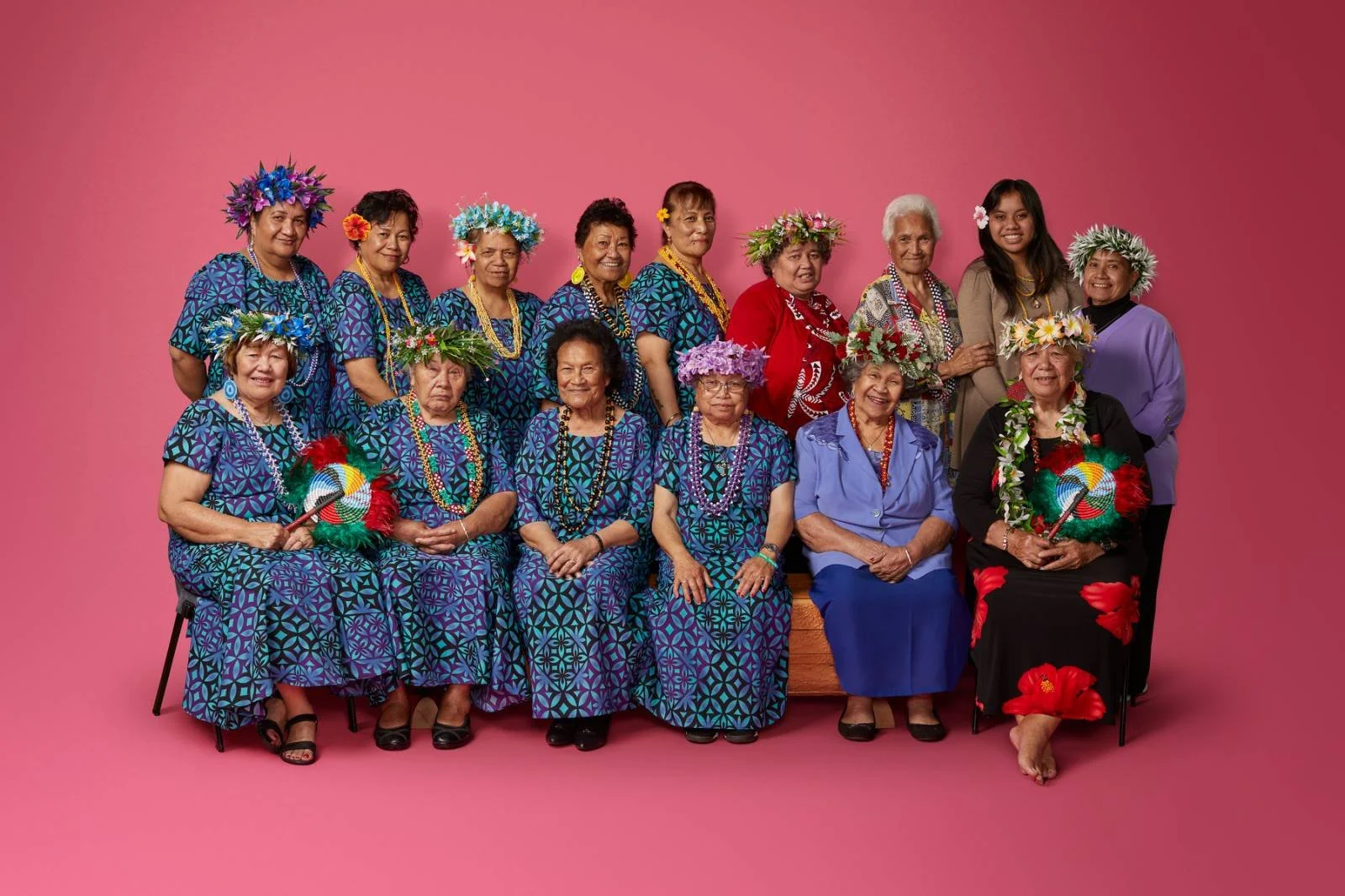Events
-
![]()
Noken publication is now available
On Monday 4th August 2025 we officially closed the Noken exhibition at UoA Waipapa Taumata Rau - Pacific Collaborative Space L1- Mātauranga Whānui General Library.
The publication was launched by several of the West Papuan students along with Associate Professor Gordon Nanau, Co-Head of Māori and Pacific Studies.
If you are interested in purchasing a copy of the Noken publication please see ‘contact’ below.
-
![]()
Noken exhibition now open at Tāmaki Pātaka Kōrero - Central City Library
Excited to share that we officially opened our Tāmaki Pātaka Kōrero - Central City Library satellite of ‘Noken’ on Tuesday 5th August 2025.
Please feel free to go along to:
Level 1, Tāmaki Pātaka Kōrero, Central City Library
Address: 44 / 46 Lorne Street, Tāmaki Makaurau Auckland Central, Aotearoa New Zealand.
-
![]()
Taimwanuokai – Forget Me Not closing
Saturday 23rd August 2025 from 11am
Taimwanuokai: Forget Me Not highlights over a century of Kiribati knowledge, skills and artistry by master makers Kaetaeta Watson and Louisa Humphry MNZM. They chose the name Taimwanuokai because:
“It speaks to the things that we’ve done and what we’re capable of doing. Where our treasures in this exhibition are saying – don’t forget us, don’t forget our knowledge and practice of making and doing, carry on. It also relates to us as a people and carries messages of – don’t forget who you are, and don’t forget where you come from.”
Proudly supported by Creative New Zealand, Māngere-Ōtāhuhu Local Board, and Lagi-Maama Academy & Consultancy. -
![Fenoga Tāoga Niue I Aotearoa]()
Fenoga Tāoga Niue I Aotearoa Niue Heritage Journey In Aotearoa New List Item
Falepipi he Mafola Niuean Handcraft Group Inc,. official opened their Fenoga Tāoga Niue I Aotearoa on Saturday 1st April 2023 at Māngere Arts Centre - Ngā Tohu o Uenuku.
-
![]()
Tibuta - Kinaakiia Ainen Kiribati |Tibuta - Identifies Kiribati Women exhibition
Exhibition opened at Pātaka Art + Museum on Saturday 8th October 2023. This exhibition honours the significance of tibuta, Kiribati’s national tops worn by women, as markers of identity and pride.Each tibuta on display carries the legacy of grandmothers, mothers, daughters and granddaughters. They come with narratives around making practices, distinctive styles, gifting, and wearing of tibuta for life-affirming moments such as family reunions, village gatherings, and engagements. All of the stories shared in this exhibition have been lovingly authored by I-Kiribati, for I-Kiribati.
Publications
-
![]()
Sio FakaTonga ‘ae ‘Aati FakaTonga Faivā, Tufunga & Nimamea‘a FakaTonga - Tongan Views of Tongan Arts Tongan Performance Arts, Material Arts & Fine Arts
Authors: Professor Hūfanga He-Ako-Moe-Lotu Dr ‘Ōkusitino Māhina
Associate Professor Māui-Tava-He-Ako Dr Tēvita Ka‘ili
Kolokesa Uafā Māhina-Tuai MNZM.
Publisher: Kula-ʻUli Publishing
Publication Date: August 2025
ISBN: 978-0-9864531-6-8
Format: Hardback
Page Count: 292 pages
Publication Design: Alt Group (Shaun Naufahu & Giordano Zatta)
Over 13 years in the making, this book featuring 41 artists (11 whom have moved from this realm to Pulotu) and five collectives – all of Tongan heritage. This book offers an Indigenous Tongan perspective on Tongan arts. It is likely the first comprehensive book on Tongan arts, covering a continuum from ancient to contemporary knowledges and practices. The book aims to shift perspectives on Tongan art forms from a history of imposition and domination to one of mediation and liberation. The Indigenous Tā-Vā Philosophy of Reality is used to explain Tongan arts.
The three genres – faiva (performance arts), tufunga (material arts), and nimamea’a (fine arts) – are detailed with examples. Unique examples that will challenge the current status quo of what art is, is our inclusion of the late Jonah Tali Lomu and Mate Ma’a Tonga under the genre of faiva or performance art of rugby union and performance art of rugby league. We argue that Jonah Lomu has been our most famous performance artist. And Mate Ma’a Tonga as our most beloved performance artist collective. The book also uniquely traces the origins of specific Tongan arts forms to ancestors such as Hikule’o, Tangaloa, Maui, and Hina. Lastly, it is bilingual in Tongan and English.
Enquiries to barbara@lagi-maama.com
-
![]()
Taimwanuokai: Forget Me Not - Kaetaeta Watson, Louisa Humphry MNZM and edited by Lagi-Maama
Taimwanuokai: Forget Me Not highlights over a century of Kiribati knowledge, skills and artistry by master makers Kaetaeta Watson and Louisa Humphry MNZM. They chose the name Taimwanuokai because “It speaks to the things that we’ve done and what we’re capable of doing. Where our treasures in this exhibition are saying – don’t forget us, don’t forget our knowledge and practice of making and doing, carry on. It also relates to us as a people and carries messages of – don’t forget who you are, and don’t forget where you come from.”
ISBN 978-1-7386137-1-7
Designer: Lagi-Maama
Publisher: Te Rabakau Press and individual contributors as credited, 2025.
All enquiries please contact Lagi-Maama - barbara@lagi-maama.com
-
![]()
Noken / Men: String Bags of the Muyu Tribe of Southern West Papua. Edited by Veronika Triariyani Kanem, Katja Phutaraksa Neef and Lagi-Maama
Noken / Men: String Bags of the Muyu Tribe of Southern West Papua
Editors: Veronika Kanem, Lagi-Maama Academy & Consultancy (Toluma’anave Barbara Makuati-Afitu, Kolokesa Uafā Māhina-Tuai MNZM, Hikule'o Fe'aomoeako Melaia Māhina), Katja Phutaraska Neef, Janson Chau.
Publisher: Lagi-Maama Publishing
Publication Date: August 2025
ISBN (Paperback): 978-1-0670110-0-0
Format: Paperback
Page Count: 169 pages
Publication Design: Alt Group (Janson Chau)
This book Noken / Men: String Bags of the Muyu Tribe in Southern West Papuais based on the research of Veronika Kanem, a PhD student in Pacific Studies at Waipapa Taumata Rau, the University of Auckland. Noken are finely woven or knotted string bags made from natural fibres of plants and tree bark. They have different names depending on the region, language and dialect of local tribes. For the Muyu tribe in Southern West Papua, they call it ‘men’. Focusing on the socio-cultural significance of noken / men among her Muyu people, of her father Herman Kanem’s tribe.
With 35 contributors (and 22 makers and community featured), this bilingual (Papuan/Indonesian and English) book provides insights into the refined artistry, craft, making and functions of noken / men strings bag; stories from makers; impact of deforestation on customary lands; and personal reflections from West Papuan and Aotearoa.
Email barbara@lagi-maama.com
-
![]()
Tufunga Ngaohi-fangufangu & Faiva Ifi-fangufangu Material Art of Noseflute-making & Performance Art of Noseflute-playing Koe Fakamo‘ui ‘oe ‘Aati Ofimate The Revival of Neardead Arts
Hūfanga-He-Ako-Moe-Lotu, ‘Ōkusitino Māhina Siosifa Tualau Fifita mo/with Meleseini Haitelenisia Fifita ‘O Lakepa Lolohea Fetu‘u Tuai Melevesi ‘Ulukilupetea Dasia Fakaola-Mei-Langi Fifita Akesiumeimoana Tu‘ulaikemipilisi Tupou Māhina Tuai Talamu‘aki Prologue Maui-TāVā-He-Ako, Tēvita O. Ka‘ili Talamuiaki Epilogue Pā‘utu-‘O-Vava‘u-Lahi, Adriana Māhanga Lear.
It is with great pleasure and honour that I introduce this book on the Tongan noseflute. As the title suggests, "Material Art of Noseflute-making & Performance Art of Noseflute-playing, The Revival of Neardead Arts" encompasses an exploration of the Tongan noseflute, an Indigenous Tonga musical instrument, that is both a Tongan material art and a performance art.
This book explains the art of making and decorating this remarkable instrument and its performance. It is a reminder that sound is given by nature but music is socially configured in different ways from culture to culture (and from language to language).
All enquiries please contact Lagi-Maama - barbara@lagi-maama.com
-
![]()
Tibuta – Kinaakiia Ainen Kiribati Tibuta – Identifies Kiribati Women
Publication date: October 2023
Publisher: Te Rabakau Press
Exhibition 7 Oct - 11 Nov 2023 @ Pātaka Art + Museum
The Tibuta - Kinaakiia Ainen Kiribati Tibuta - Identifies KiribatiWomen exhibition features 74 tibuta, a wedding dress with tibuta inspired smocking, climate change warrior Otintaai with her flax inspired tibuta, and an insight into the process of making the Pātaka tibuta. All of these works are accompanied with the names of those that made it, wore it, gifted it and / or who now treasure them. This publication adds further insights by providing the narratives gifted by three generations and their families of I-Kiribati diaspora, now calling Aotearoa home. To date, no comprehensive exploration or collating of 'tibuta' stories through a Kiribati lens exist here in Aotearoa (and possibly the world), making this endeavour all the more significant.
All enquiries please contact Lagi-Maama - barbara@lagi-maama.com
-
![]()
Fenoga Tāoga Niue I Aotearoa Niue Heritage Journey In Aotearoa
Celebrating the 30 – year journey of Falepipi he Mafola Niuean Handcraft Group Inc, based in Ōtāhuhu since 1993.
Featuring projects and treasures made by Falepipi he Mafola Niuean Handcraft Group Inc, this exhibition honours over 50 loved ones who have since passed on and the wealth of knowledges, skills and wisdom of the current members – tāoga, treasures.
From the villages of Tuapa Uhomotu, Alofi, Namukulu, Makefu, Liku, Hikutavake, Hakupu, Avatele, Tamakautoga, Mutalau and Toi, the Falepipi he Mafola Group has been meeting at the Ōtāhuhu Town Hall Community Centre in Tāmaki Makaurau Auckland every Thursday from 10am to 2pm since 1993 and continues to do so. It plays an invaluable role in continuing, revolving and preserving the knowledges and practices of Niuean culture and heritage in Aotearoa.
The Fenoga Tāoga Niue I Aotearoa – Niue Heritage Journey In Aotearoa season at Pātaka represents a homecoming for some of the Falepipi he Mafola group, including founding member, Molima Molly Pihigia QSM, who spent many years living in Porirua.
Image : Falepipi he Mafola Niuean Handicraft Group Inc, 2022
Courtesy of Falepipi he Mafola Group Inc. Photography by Toaki Okano.ISBN: 978-1-738-584-703
All enquiries please contact Lagi-Maama - barbara@lagi-maama.com
TALANOA
One of our core values as Lagi-Maama Academy & Consultancy is to embrace and be empowered by our Indigenous knowledge and practice of talanoa or “talking critically yet harmoniously.”
Our ancestors actively practiced talanoa, as a decision-making tool that helped, to refine the best and permanence in creative and innovative thinking throughout our wider Moana Oceania region. We draw on and utilise our collective inheritance of knowledges and skills from our ancestors, which have been passed down through our own bodies and systems of Indigenous ways of knowing, seeing and doing, where ‘talking critically yet harmoniously’ has always been part of our status quo.
These knowledge and skills are composed in culture and communicated in language, as social vessels.












